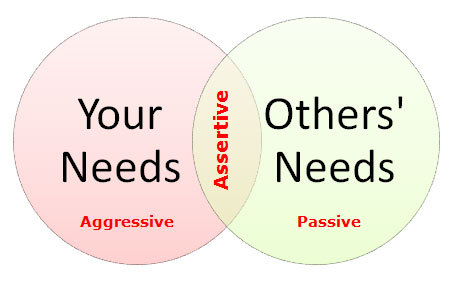Effective assertiveness is a balance between your needs and maintaining the relationship with the other person. In any interpersonal interaction, the moment we ask for something or have to say no to a request, we are making a choice; my discomfort or theirs? Too often, we error towards one side or the other. When we choose the former, in some sense, this makes us feel in control. We don't have to feel the vulnerability of disappointment or risk judgment in the moment. Unfortunately, the cost over the long run is often resentment, which can lead to passive aggressive communications, and deterioration in the relationship. When we over rely on, or are not skillful in the later (their discomfort), we may be perceived as pushy. The cost can be arguments, interpersonal disputes, and residual guilt, which leads to an endless cycle of exhausting relationship repair efforts.
So how do we step through these barriers and increase the likelihood of getting what we want, without creating so much discomfort in the other person as to loose the relationship? Here are the three simple steps to effective assertiveness that I teach all of my clients:
The VAR skill
Step I. Validate the other person's side of things. Consider the discomfort you will be imposing on the other person by asking for something or saying no to a request. Validation (acknowledging, honoring) is the lubricant for getting the change you desire. People are more willing to do things they feel are acknowledged as difficult, rather than expected and the difficulty minimized. E.g. "I know you are super busy, and another thing on your plate is the last thing you need." or "I can understand where you are coming from on this." Or just a simple "I hear you." Use a tone of voice that communicates this understanding.
Step 2. Assert: Ask or say no clearly, directly, and behaviorally. So often we ask for others to make us feel a certain way, such as, "I want to feel like you have my back." or "I want your support on this." But what does that mean specifically? Do you need physical support, financial support, emotional support? And what specifically would that look like? Choose words that specify the exact behavior(s) you would like to see, which might lead to the desired feeling.
For example, if you want your husband to "be more considerate," you must spell it out. " Could we please take 10 minutes to sit together at the end of the day, where you ask about my day?" People feel good when they can check the box and say to them self "Done!" Asking specifically and behaviorally reduces the discomfort of uncertainty in the other, and increases the likelihood that they will agree to your request.
Step 3. Reinforce: Next, to increase the likelihood that they do the behavior, offer them a reinforcement for their agreement. This might be a simple negotiation offer. E.g. "If you do this for me, I will do this for you." Or, if the relationship is a strong one, simply telling the person how much it would help you for them to do this for you. The trick here is to tell the other person what is in it for them! If you need to say "no" to a request, after validating their disappointment, reinforce their patience or understanding with a simple thank you. E.g. "Thanks so much for understanding!"
The Power Differential
When we assert ourselves it is essential to be aware of the power differential. When the person you are addressing is in a position of more power in a given situation (e.g. your boss, professor, someone more experienced, etc.), or the relationship is not strong, it is important to lean more heavily on the V. In this type of situation, be more willing to offer and accept a compromise or a no.
If you are in the natural position of power or the relationship is strong, you can lean more heavily on the A. The critical piece here is to be crystal clear and willing to acknowledge the action as meaningful. Tell them what is in it for them. Be generous with praise and reinforcements to support the relationship long-term.
